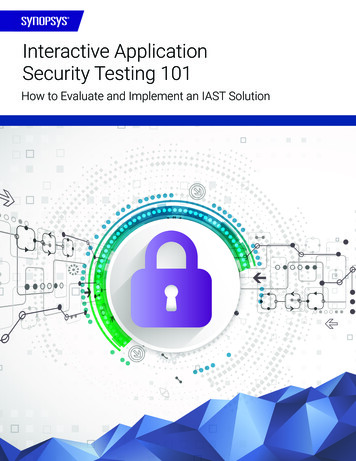
Transcription
Interactive ApplicationSecurity Testing 101How to Evaluate and Implement an IAST Solution
Table of contentsWhat is IAST?.1Why should I care about IAST?.2How is IAST different from other AppSec tools?.3Dynamic application security testing . 3Static application security testing . 3Interactive application security testing. 3How can I benefit from IAST?.41. Actionable findings for development teams . 42. Comprehensive vulnerability and security risk reporting earlier in the SDLC. 43. Low false-positive rates . 44. Seamless integration into automated development and testing environments . 4What should I look for in an IAST solution?.5
The who, what, andwhy about the nextbig thing in AppSecMany are hailing interactive application security testing (IAST) as the next step in theevolution of application testing, and for good reason. As more organizations adoptDevSecOps, they’ll need to consider how traditional application security testing tools fitinto this new paradigm. A 2019 Gartner report on DevSecOps recommends IAST as analternative tool, stating, “IAST incorporates attributes of both SAST and DAST, leveraginginstrumentation of the application during testing. This combination enables IASTapproaches to provide a better balance of efficacy—the reduced false positives of DASTwith the precise line of code and code coverage visibility of SAST.”1IAST provides some distinct advantages over traditional application security testingmethodologies. In this eBook we introduce this exciting new technology and explain whyit’s set to disrupt the application security testing world. Continue reading to see why nosoftware security toolkit is complete without an IAST solution.What is IAST?Interactive application security testing is a software security testing technique that analyzes the behavior of webbased applications as they run. IAST solutions typically work by deploying agents in a running application. Theseagents continuously analyze the application’s interactions (usually initiated by automated tests) to identify securityvulnerabilities. IAST sees every line of code as it is executed and the stack trace, memory values, and actualdataflow of an application as it responds to each HTTP(S) request. Some IAST solutions can not only activelymonitor security vulnerabilities (e.g., SQL injection) but also verify them and show that they are real and exploitable.Then they produce a vulnerability report with line-specific remediation advice, empowering developers to fix actualprioritized vulnerabilities immediately.One of the features that define IAST is where it is normally implemented in the SDLC: IAST typically runs in theintegrated test and QA stage. By pushing security testing left from production (where DAST usually takes place),teams can catch runtime vulnerabilities earlier, thereby reducing remediation costs, eliminating delays, and reducingthe risk of breached applications.The best IAST tools provide integration with software composition analysis (SCA) tools, which can scan binary filesfor third-party and open source components and report known vulnerabilities associated with those components,as well as their associated licenses and other valuable information. synopsys.com 1
Why should I care about IAST?Web applications run by large organizations are ideal attack vectors for hackers wishing to access sensitivepersonal data, intellectual property, and more. According to the 2019 Verizon Data Breach Investigations Report,web application attacks remain one of the top attack vectors across multiple industries.2 These breaches oftencause significant financial damages and long-term damage to a business’s reputation. Here are just a fewrecent examples: 880,000 payment cards were exposed on travel booking site Orbitz.3Three months’ worth of payment data was stolen from Rail Europe’s American website.4Up to 40,000 customers had their payment information taken from Ticketmaster’s U.K. website.5And of course, the infamous Equifax breach resulted in more than 145 million people’s personal databeing exposed.6Though Equifax happened in summer 2017—what seems like ages ago in the world of cyber security—it continuesto resonate, not only because of its wide-ranging impact but also because it would have been so easy to prevent.Traditional application security testing methods provide a layer of defense by helping you find and fix potentialvulnerabilities, but they differ in how they scan and test applications. Some are better than others at finding thesethreats depending on a host of conditions, including the testing environment, the stage in the software developmentlife cycle (SDLC), and general use cases.These differences create a dilemma for organizations: If they do not select the right tools, they might unwittinglyexpose their web apps to an unforeseen attack. Fortunately, IAST solutions lessen these headaches fororganizations by shifting testing left, so problems are caught earlier in the development cycle, reducing remediationcosts and eliminating delays—all without disrupting normal workflows.Security teams need tools thatcan give them a continuouslyupdated view of the riskposture of their web appsand compliance with securitystandards before those apps aredeployed to production. synopsys.com 2
How is IAST different from other AppSec tools?To keep pace with the demand for rapid development of web applications, organizations need accurate andautomated security testing tools that can easily scale and produce actionable results. Static analysis, the mostprevalent application security testing solution today, provides comprehensive analysis of static source code,but can't identify runtime vulnerabilities found via dynamic testing. While static analysis tools typically detecta high number of vulnerabilities and produce accurate true positives, they also generate a high volume of falsepositives. This is because testing occurs early in the coding and development phase as opposed to detection at theapplication binary runtime level.Alternatively, dynamic and manual testing find vulnerabilities at application runtime and help reduce the volume offalse positives. However, they do not provide much detail on the vulnerabilities they detect, or remediation advice.These vulnerabilities require additional review and validation cycles by security experts, increasing the workload ofalready strained security resources and development teams.Dynamic application security testingDAST tools test running applications from the outside in by attacking them externally.Coverage is limited because DAST solutions are essentially blind as to what is happeninginside an application. Challenges include moderate false-positive rates, an increasednumber of testing cycles, and increased testing duration. Finally, DAST results offer nocode guidance as to where software vulnerabilities are located, making it difficult fordevelopers to easily fix identified vulnerabilities. DAST tools can’t effectively achieve thefast turnaround times required in CI/CD workflows, unlike IAST, which produces real-timeresults and detailed insights for timely remediation.Static application security testingAlternatively, SAST solutions are great at identifying security weaknesses and providingcode-level guidance as to where and how to fix vulnerabilities in source code. And theyprovide integrations for developer IDEs, issue trackers, and build tools to support CI/CDworkflows. But SAST is blind to how all the pieces of an application work together andoperate at runtime, so it can’t detect vulnerabilities in running applications that hackersmay be able to exploit. In addition, SAST reports can be overwhelming, identifying manypotential vulnerabilities.Interactive application security testingIAST fills the gap between traditional static and dynamic testing and is a great complementfor teams adopting DevOps and continuous integration and continuous delivery (CI/CD)practices. IAST solutions allow users to find and fix security vulnerabilities using real-timedata and work in running applications. They quickly identify a broader range of runtimevulnerabilities with greater accuracy than DAST and SAST solutions, and they do so downto the line of code that should be fixed. Some IAST solutions include SCA and e-learning,which enable teams to learn about and fix vulnerabilities in third-party and open sourcecomponents easily. Because IAST provides real-time results in mere seconds, it is the onlytype of dynamic runtime testing that can support DevSecOps and quick-turnaround CI/CD processes. It can alsobe easily integrated into the existing development and testing cycle, allowing security and development teams toexpend their time and energy on true positives that matter. synopsys.com 3
How can I benefit from IAST?1. Actionable findings for development teamsIn a report by Forrester, IAST was shown to reduce the time it took to remediate security vulnerabilities by 65%,compared to penetration testing.7 This is because IAST empowers developers to find and fix vulnerabilities as apart of their development process. Application security experts can remove themselves from the critical path ofsoftware development and spend more time on strategic security initiatives.2. Comprehensive vulnerability and security risk reporting earlier in the SDLCIAST enables developers to fix security vulnerabilities as they code, reducing reliance on external security testersfor pen testing. This means you can find and fix runtime vulnerabilities in web apps before deploying them toproduction. Shifting left and doing security testing earlier in the integrated build and testing stages enablessubstantial cost and resource savings for organizations, while also reducing security risk.3. Low false-positive ratesIAST solutions are automatic and accurate; they won’t return long lists of potential vulnerabilities that requirelengthy, tedious manual review to resolve and eliminate false positives. So organizations can focus DAST and pentesting budgets on more difficult corner-case vulnerabilities that require more intensive manual human testing toidentify and verify.4. Seamless integration into automated development and testing environmentsIf development teams are to adopt security testing as part of their normal workflows, an application securitysolution must be able to plug into and integrate with agile and CI/CD development tools. It also must be easy todeploy, update, and scale to support large enterprise requirements. IAST solutions integrate seamlessly into CI/CDpipelines and run at the speed demanded by DevOps.Both security and development teams can benefit from integrating IAST into the SDLC, especially an IAST toolthat includes SCA and e-learning. Security teams need application security tools that can comprehensively findvulnerabilities and give them a continuously updated view of the risk posture of their organizations’ web apps andcompliance with security standards. And they need this information before web apps are deployed to production,where they’re at risk of security attacks that may lead to costly data breaches.Development teams, by contrast, need quick feedback on what vulnerabilities to fix, how to fix them, and where tofind them in their source code or component libraries. And developers need this feedback early in the SDLC, whenthey’re most familiar with their code and when vulnerabilities are least costly to fix.IAST solutions integrate seamlessly intoCI/CD pipelines and run at the speeddemanded by DevOps. synopsys.com 4
What should I look for in an IAST solution?IAST has many distinct advantages over traditional solutions, which is why it’s poised to be the next big thing in thesecurity industry. No matter what solution you choose, we recommend you consider the following:Must-haveWhy it’s important1. Updated security dashboardsfor standards compliance:PCI DSS, GDPR, OWASPTop 10, SANS/CWEYou need insight into security risks, trends, and coverage, as well assecurity compliance for running web apps (including custom code andopen source components).2. Fast, accurate, andcomprehensive resultsout of the box, with lowfalse-positive ratesYou need to spend less time finding and remediating false positives. Butyou can’t waste time configuring and tuning your tools to reduce them.3. Automated identification andverification of vulnerabilitiesYou want to free up your teams to find and fix more complex vulnerabilities.So you need a tool that verifies each vulnerability and doesn’t inundate youwith false positives.4. Sensitive-data tracking (e.g.,PII and company IP)You need to achieve compliance with key industry security standards (e.g.,PCI DSS and GDPR) by setting parameters to automatically track sensitivedata in applications.5. Ease of deployment inDevOps and agile workflowsYour web app development and DevOps teams rely on agile developmentand automation. So they need AppSec tools that seamlessly integrate withstandard build, test, and collaboration tools and “just work.”6. Enterprise-grade SCA binaryanalysis integrationYou need visibility into security vulnerabilities and license types andversions in open source and third-party components, libraries, andframeworks.7. Real-time insights, detailedremediation guidance withcontextual learningYour developers need detailed information about vulnerabilities and wherethey are located in their code, as well as contextual guidance on how toremediate them.8. Ability to scale andsupport moderndevelopment and deploymentYou need an IAST solution that can easily scale, bind together multiplemicroservices from a single app for assessment, and support containerdeployment. synopsys.com 5
Why Seeker?Seeker is an enterprise-scale IAST solution that fits seamlessly into CI/CD development workflows. Easy to useand deploy, Seeker can quickly process hundreds of thousands of HTTP(S) requests with extreme accuracy. Unlikeother IAST solutions, Seeker uses active verification to automatically validate whether each identified vulnerabilityis exploitable, reducing false positives to near zero and providing tremendous time and cost savings. Seeker’sinnovative sensitive-data tracking feature, the first in the industry, provides the utmost visibility into where your mostcritical information is stored with weak or no encryption, helping you ensure compliance with PCI DSS, GDPR, andother security standards and regulations.References1.2.3.4.5.6.7.Gartner, Neil MacDonald and Dale Gardner, 12 Things to Get Right for Successful DevSecOps, Dec. 19, 2019.Verizon, 2019 Data Breach Investigations Report, 2019.Dani Deahl, Orbitz Says a Possible Data Breach Has Affected 880,000 Credit Cards, The Verge, March 20, 2018.Zack Whittaker, Rail Europe Had a Three-Month Long Credit Card Breach, ZDNet, May 14, 2018.Taylor Armerding, GDPR Raises the Stakes on Data Breaches, Synopsys Software Integrity Blog, July 12, 2018.Lily Hay Newman, Equifax’s Security Overhaul, a Year After Its Epic Breach, WIRED, July 25, 2018.Amy DeMartine, Construct a Business Case for Interactive Application Security Testing, Forrester, Nov. 2017.Shift left with SeekerFor more information on how Seeker can help you shift leftand optimize your application security testing strategy,visit synopsys.com/iast.LEARN MORE synopsys.com 6
The Synopsys differenceSynopsys helps development teams build secure, high-quality software, minimizing risks whilemaximizing speed and productivity. Synopsys, a recognized leader in application security,provides static analysis, software composition analysis, and dynamic analysis solutions thatenable teams to quickly find and fix vulnerabilities and defects in proprietary code, open sourcecomponents, and application behavior. With a combination of industry-leading tools, services,and expertise, only Synopsys helps organizations optimize security and quality in DevSecOpsand throughout the software development life cycle.For more information, go to www.synopsys.com/software.Synopsys, Inc.185 Berry Street, Suite 6500San Francisco, CA 94107 USAContact us:U.S. Sales: 800.873.8193International Sales: 1 415.321.5237Email: sig-info@synopsys.com 2020 Synopsys, Inc. All rights reserved. Synopsys is a trademark of Synopsys, Inc. in the United States and other countries. A list of Synopsys trademarks is available atwww.synopsys.com/copyright.html . All other names mentioned herein are trademarks or registered trademarks of their respective owners. May 2020 synopsys.com 7
Interactive application security testing is a software security testing technique that analyzes the behavior of web-based applications as they run. IAST solutions typically work by deploying agents in a running application. These agents continuously analyze the application’s interactions (u










![[Anonymized] Web application penetration testing report](/img/22/anonymized-web-application-penetration-testing-report.jpg)